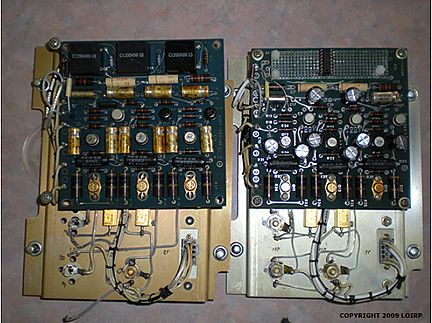To: LOIRP Status
From: Dennis Wingo
Subject: Progress Report, Milestone ALERT! Folks Major milestones to report!
Demodulator
We have had a major milestone accomplished (well 98% of the way there). Figure 1 shows two framelets, from Lunar Orbiter II High Resolution image (we don’t know which one yet). Figure 2 shows our favorite image, the Lunar Orbiter 1 image of the Earth with two framelets that were captured from the undemodulated tape. The framelets that are stitched together are from LO-1-102.
This proves that we can demodulate random tapes from more than one Lunar Orbiter mission but it has also shown us what we have to do to get to full production mode. The demodulator must be ultra stable, however, the drive is still not to its original specification and so there is jitter in the signal. The new capstan motor should fix this as we have new belts, bearings, and the motor has been balanced back to its original specification. However, the the motor driver assembly that we built to use during the calibration process blew some power transistors and he had to come back down (he is in San Francisco) and pick up one of our spares. We have been building spares for the production process to keep the machines running and this is helping with the refurb process as well! We will have the capstan motor on Saturday and will install and align it on Monday.
Al Sturm is going back and doing some further refining of the demodulator design to account for some loss of demodulator lock on the signal found during the testing yesterday. This accounts for the striping that you see on the Lunar Orbiter II framelets that we captured and processed shown on the next pages. We have not found out what frame this is and it is possible (as I have looked through all of the LO-II images) that we have one that is not in the current database as one image is missing from the LPL database that may be ours. If this is true, then we are helping to fill out the complete LO image database for NASA. One final note, look at the final image and see the boulders sitting on the surface at the edge of the crater!
Software
Gordon Woodcock has done some test automated assemblies of a couple of framelets which looks like it will result in a workable and at least semi-automated process for framelet reassembly.
Second Machine
We are continuing to install new caps and refurbished subassemblies that Ken and I have modified for better operation. It is our plan to finish the motor replacements, upgrades, and testing on the primary machine to get it ready for production before finishing up the second drive. This is as our experience gained on the first drive and the design upgrades will make the second drive relatively easy to get going after the learning curve of working on the first machine.
Images
Figure 1 is an unknown high resolution image from Lunar Orbiter II. These are individual framelets and we are still searching to figure out which whole image that it is attached to. The lines through the images are artifacts from the demodulator that is not quite 100% working – yet. The image has boulders sitting on the surface quite easy to see. We have verified that the intrinsic resolution of these images is going to be very high, to be quantified further after we get the demod at 100% and the capstan motor replaced. Figure 2 is a composite from LO-I-102-H that we processed from the undemodulated tape.
Figure 1: Unidentified high resolution framelet from Lunar Orbiter II. Image LOIRP/NASA

Figure 2: composite from LO-I-102-H Larger image. Image LOIRP/NASA
Discussion
We are closing in on satisfying all of the milestones from this phase of our project and we are looking forward to getting the go ahead and funding to enter the production phase. It is our plan to take a series of new images with us to the Lunar and Planetary Science conference in Houston to show what can be done with data mining these old data sets. We expect to be able to digitize any tape at will by next week and have a set of images that are the high priority outputs. I am extremely proud of our team and what has been accomplished and look forward to providing this raw data and finished products for NASA’s exploration and science efforts.
Respectfully Submitted
Dennis Ray Wingo









